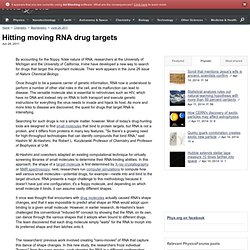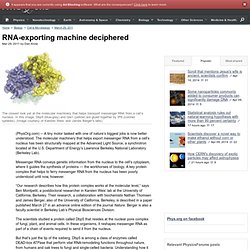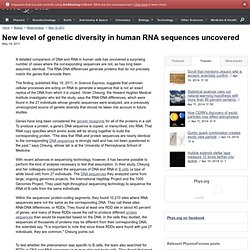

PhysOrg Science News: New roles emerge for non-c... PhysOrg Science News: Breakthrough lights way fo... Hitting moving RNA drug targets. By accounting for the floppy, fickle nature of RNA, researchers at the University of Michigan and the University of California, Irvine have developed a new way to search for drugs that target this important molecule.

Their work appears in the June 26 issue of Nature Chemical Biology. Once thought to be a passive carrier of genetic information, RNA now is understood to perform a number of other vital roles in the cell, and its malfunction can lead to disease. The versatile molecule also is essential to retroviruses such as HIV, which have no DNA and instead rely on RNA to both transport and execute genetic instructions for everything the virus needs to invade and hijack its host. As more and more links to disease are discovered, the quest for drugs that target RNA is intensifying. Searching for such drugs is not a simple matter, however. The researchers' previous work involved creating "nano-movies" of RNA that capture this dance of shape changes. PhysOrg Science News: Hitting moving RNA drug ta... PhysOrg Science News: Non-coding RNA has role in...
PhysOrg Science News: Noncoding RNA may promote... Better vaccines thanks to RNA. Non-coding RNA has role in inherited neurological disorder. Jun 21, Neuroscience Researchers have discovered that expression of the ataxin‑7 gene - the cause of the neurological disorder spinocerebellar ataxia type 7 - has two regulators: a highly conserved, multi‑tasking protein called CTCF and, surprisingly, an adjacent promoter containing non‑coding RNA.

Credit: Illustration courtesy of Christina Takamatsu‑Butler, UC San Diego. A team of scientists, led by researchers at the University of California, San Diego School of Medicine, have uncovered a novel mechanism regulating gene expression and transcription linked to Spinocerebellar ataxia 7, an inherited neurological disorder. The discovery promises to have broad ramifications, suggesting that abundant non-coding transcripts of ribonucleic acid (RNA) may be key players in neurological development and function, and could be powerful targets for future clinical therapies. La Spada and colleagues have long studied SCA.
The researchers found not one, but two, regulators. Noncoding RNA may promote Alzheimer's disease. May 30, Medical research Researchers show that the small RNA 38A spurs cells to manufacture Var IV, a splice variant of a key neuronal protein, and potentially promote Alzheimer's disease.

In this image, Var IV (green) is prevalent in cells that make extra 38A (left) but rare in control cells (right). Credit: Massone, S., et al. 2011. J. Cell Biol. doi:10.1083/jcb.201011053. Researchers pinpoint a small RNA that spurs cells to manufacture a particular splice variant of a key neuronal protein, potentially promoting Alzheimer's disease (AD) or other types of neurodegeneration. Like a movie with an alternate ending, a protein can come in more than one version.
RNA-exporting machine deciphered. (PhysOrg.com) -- A tiny motor tasked with one of nature’s biggest jobs is now better understood.

The molecular machinery that helps export messenger RNA from a cell’s nucleus has been structurally mapped at the Advanced Light Source, a synchrotron located at the U.S. Department of Energy’s Lawrence Berkeley National Laboratory (Berkeley Lab). Messenger RNA conveys genetic information from the nucleus to the cell’s cytoplasm, where it guides the synthesis of proteins — the workhorses of biology. A key protein complex that helps to ferry messenger RNA from the nucleus has been poorly understood until now, however. “Our research describes how this protein complex works at the molecular level,” says Ben Montpetit, a postdoctoral researcher in Karsten Weis’ lab at the University of California, Berkeley. The scientists studied a protein called Dbp5 that resides at the nuclear pore complex of fungi, plant, and animal cells.
New level of genetic diversity in human RNA sequences uncovered. A detailed comparison of DNA and RNA in human cells has uncovered a surprising number of cases where the corresponding sequences are not, as has long been assumed, identical.

The RNA-DNA differences generate proteins that do not precisely match the genes that encode them. The finding, published May 19, 2011, in Science Express, suggests that unknown cellular processes are acting on RNA to generate a sequence that is not an exact replica of the DNA from which it is copied. Vivian Cheung, the Howard Hughes Medical Institute investigator who led the study, says the RNA-DNA differences, which were found in the 27 individuals whose genetic sequences were analyzed, are a previously unrecognized source of genetic diversity that should be taken into account in future studies.
Genes have long been considered the genetic blueprints for all of the proteins in a cell.